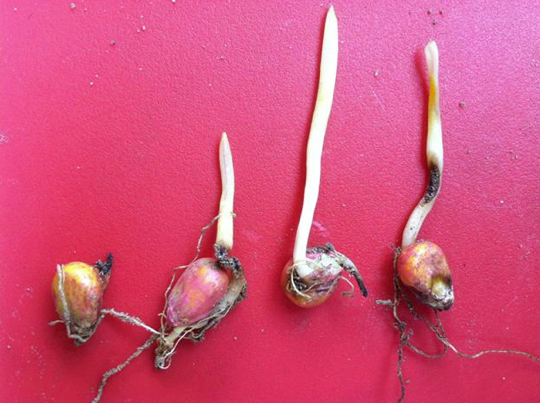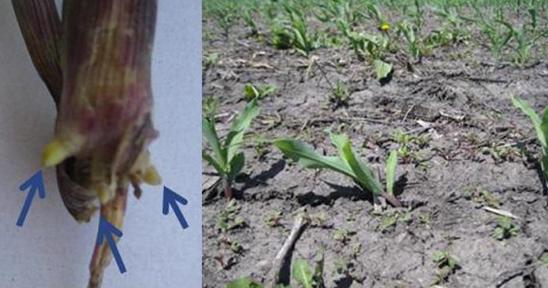Each spring season brings forth challenging situations for young corn plants to overcome.
|
|
Fertilizer burn and rootless corn syndrome are two challenges that are showing up in some areas of the Northern Corn Belt in 2012.
Fertilizer Burn
In-furrow fertilizer applications can be a good way to supply a small dose of nutrients to young corn seedlings to jumpstart their emergence and early growth.
Often, insecticides and/or biological growth promotion products are added to the fertilizer, making the in-furrow application more enticing because we are applying 2-3 products with one shot.
In many years, we do not see any issues with in-furrow applications. Drier than normal soils this spring (map below shows departure from normal temperature) have led to some fertilizer burn on radicles and mesocotyls where 4-5 gallons or more of 10-34-0 or other products were applied in the furrow. Fertilizer burn symptoms are shown in the photos below.
Similar issues can be seen where anhydrous ammonia was applied to at a shallow depth to dry soils this spring. Minor cases of fertilizer burn delay emergence and reduce seedling vigor.
Major cases burn the radicle and mesocotyl all the way back to the seed and reduce plant stands. Sandy soils, higher rates of fertilizer, and low quality fertilizer are all possible contributors that have combined with the dry conditions to cause damage in corn fields. Many times rainfall helps young corn plants overcome fertilizer burn damage.
Early Season Root Development and Rootless Corn Syndrome
In some areas, wet conditions in late-April and early-May delayed corn planting until about May 10th. Some of those first-planted fields as conditions dried out could have benefitted from waiting another day or two.
Sidewall compaction resulted from the seed disk smearing the wet soil as it ran through the ground. These hard conditions make it very hard for corn roots to penetrate the sidewall and "hatchet roots" are formed. Reduced nutrient uptake, reduced anchoring ability, and reduced overall root mass are the result and are enhanced by the hot and dry conditions we have experienced recently.
|
|
Another result of "damp planting" followed by hot and dry weather is the seed furrow opening back up. In some cases, plants are initially unharmed and emerge fine. In other cases, the seed furrow and seed itself dries out and will emerge very late after enough moisture is received or will not emerge at all.
The nodal root system begins developing at V2. Until V3, the corn plant gets most of its nutrients from the seed and seminal root system. With good soil and seedbed conditions, the nodal root system has taken over the water and nutrient supplying responsibility and anchors the plant in the soil by the V6 stage.
Stresses such as compaction, dry, hot, and clumpy soils, sandblasting, insect damage, and seedling diseases can limit the ability of the nodal roots to establish and penetrate the soil. "Rootless corn syndrome" or "floppy corn syndrome" results when small or absent nodal root systems are not able to hold up the growing corn plant that gets increasingly top-heavy as it gets taller.
Curling of leaves and loss of green color are early signs of poor root development. In severe cases of rootless corn syndrome, the first sets of nodal root tips never develop. Corn plants in these situations continue to rely on the seed and seminal root system for nutrition and anchoring. A damaged or broken mesocotyl will cause the plant to fall over.
Once plants fall over, they might not recover even if conditions occur that would normally allow rooting to take place. Moisture is needed before plants fall over to soften the soil and aid in establishment of the nodal roots.

 Fertilizer burn on roots and mesocotyls found in areas of a field with very sandy soils (AgriGold photo).
Fertilizer burn on roots and mesocotyls found in areas of a field with very sandy soils (AgriGold photo). Nodal root tips that have dried out from coming into contact with dry, hot or hard soils don't continue to grow, and weak nodal root support leads to "floppy corn" (right). (AgriGold photo.)
Nodal root tips that have dried out from coming into contact with dry, hot or hard soils don't continue to grow, and weak nodal root support leads to "floppy corn" (right). (AgriGold photo.)




Post a comment
Report Abusive Comment